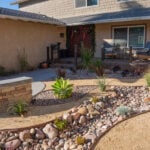In the current epoch dominated by the pursuit of convenience and the omnipresence of the digital realm, traditional norms are experiencing a profound metamorphosis. Therefore, the classical trajectory of landscape design, steeped in the traditions of face-to-face consultations and prolonged planning sessions, has gracefully adapted to the zeitgeist. This adaptation is manifested in the embrace of the virtual sphere, championed by the emergence of online landscape design services.
Moreover, gone are the days tethered to geographical constraints or restricted by the limitations of local expertise. These innovative platforms have effectively unfurled the canvas of creativity, fundamentally reshaping the landscape design landscape. Furthermore, they offer a seamless transition from the customary reliance on physical interactions to the realm of virtual collaborations and digital innovation.
The Evolution
Historically, landscape design was a process that required face-to-face interactions between clients and designers. Therefore, clients would seek out local professionals, schedule consultations, and spend extensive time discussing their preferences, ideas, and budgets. This traditional approach, while effective, often limited choices to local expertise and could be time-consuming.
However, the advent of technology and the internet has disrupted this conventional model. Online landscape design services emerged, breaking geographical barriers and offering a more accessible, streamlined, and cost-effective alternative. Moreover, these platforms allow users to explore a myriad of design options, collaborate with professionals remotely, and visualize their dream outdoor space right from the comfort of their homes.
How They work
The process of utilizing online landscape design services typically involves several key steps:
- Initial Consultation: Users start by signing up on the platform and providing information about their outdoor space, including measurements, photos, and a brief of their preferences.
- Designer Matching: Based on the provided details, users are paired with a landscape designer or a team of designers specializing in their specific needs and style preferences.
- Collaborative Design: Through online communication channels such as chat, video calls, and email, clients work closely with the designers to discuss ideas, review concepts, and iterate on designs until they are satisfied.
- Final Renderings and Plans: Once the design is finalized, clients receive detailed renderings, plans, and sometimes even 3D models or virtual walkthroughs of their proposed outdoor space.
- Implementation Guidance: Some platforms go a step further by offering guidance on implementing the design, providing plant lists, material recommendations, and even connecting clients with local contractors.
Advantages
1. Accessibility and Convenience:
Online platforms transcend geographical boundaries, enabling individuals from various locations to access top-tier designers without being limited by proximity.
2. Cost-Effectiveness:
Compared to traditional landscape design services, online options often come at a fraction of the cost, making professional designs more affordable and accessible to a wider audience.
3. Time Efficiency:
By leveraging digital tools, the design process becomes more streamlined. Therefore, eliminating the need for multiple in-person meetings and accelerating the pace of design iterations.
4. Variety and Customization:
These platforms often offer a diverse range of design styles and options. Moreover, allowing clients to explore various ideas and customize their outdoor space according to their preferences.
5. Visualization Tools:
Cutting-edge technology allows for immersive visualizations, including 3D models and virtual walkthroughs. Therefore, giving clients a realistic preview of their envisioned outdoor space.
Challenges and Considerations
While online landscape design services offer a plethora of advantages, there are some considerations and challenges to keep in mind:
Limited Physical Presence: Some clients might prefer face-to-face interactions and physical presence during the design process, which online services might not fully provide.
Site Limitations: Designing remotely may present challenges in accurately assessing the site’s unique features, such as soil conditions, drainage issues, or specific microclimates.
Communication Hurdles: Misinterpretation of design preferences or communication gaps can occur due to the reliance on digital communication tools.
Leading Online Platforms
Several notable platforms have emerged in the online landscape design arena, each offering its unique features and approaches:
Needforbuild: Known for its vast database of design ideas and professionals, needforbuild offers a platform for connecting homeowners with landscape designers and contractors.
Home Outside: This platform specializes in outdoor design and provides users with tools to visualize their ideas through their user-friendly interface.
Upwork and Fiverr: These freelance platforms host a pool of talented landscape designers. They offer their services remotely, catering to various budgets and styles.
Future of Outdoor Design
As technology continues to advance, the landscape design industry is poised for further innovation. Augmented reality (AR) and virtual reality (VR) technologies are increasingly being integrated into these platforms. They offer clients an immersive experience where they can virtually walk through their future outdoor space.
Moreover, the shift towards sustainable and eco-friendly designs is gaining momentum. With online services incorporating environmentally conscious practices and suggesting native plant choices and water-saving solutions.
Redefining Outdoor Innovation
These online landscape design services transcend the confines of traditional boundaries, redefining the very essence of outdoor space innovation. Therefore, through the fusion of technology and design acumen. These platforms dismantle geographical barriers, granting individuals across regions unprecedented access to an expansive pool of design virtuosos.
Moreover, by harnessing the power of virtual collaboration tools and cutting-edge visualization techniques, these platforms empower homeowners with an arsenal of possibilities. They offer an array of design styles, customizations, and inspirations that cater to diverse tastes and preferences. Whether it’s a serene garden retreat or a vibrant entertainment area, these services serve as conduits for transforming visions into breathtaking realities.
As these platforms continue to evolve, they pave the way for a landscape design landscape. That is inclusive, innovative, and eco-sensitive. The future beckons, promising a harmonious blend of technology and nature. In this the creation of the perfect outdoor sanctuary is just a few clicks away.






